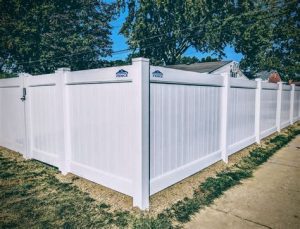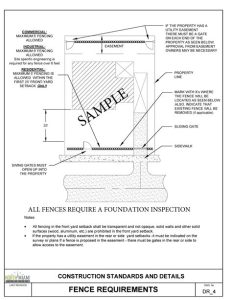Explore the environmental impacts of deforestation, carbon footprints, habitat disruption, pollution, and waste management related to fence materials in this comprehensive guide.In an era where environmental awareness is at the forefront of our minds, even seemingly straightforward home improvement projects like fence installation can have significant ecological consequences. While a well-constructed fence can enhance privacy and curb appeal, it’s essential to consider the potential impact on local ecosystems. This blog post delves into the environmental effects of DIY fence installation, exploring critical issues such as deforestation, the carbon footprint associated with various materials, and the disruption of wildlife habitats. Additionally, we will discuss how soil and water pollution can stem from this process and the importance of responsible waste management. By understanding the broader implications of our choices, we can make more informed decisions that protect our planet while beautifying our homes. Join us as we uncover the hidden costs of fence installation and explore sustainable alternatives.
Deforestation and land clearing
Deforestation and land clearing are significant environmental concerns that arise from various human activities, including the installation of fences. When individuals opt for DIY fencing solutions, it often involves clearing vast areas of land to make way for posts, panels, and other materials. This clearing process not only destroys local vegetation but also disrupts the habitat of numerous species.
The consequences of land clearing are dire. Trees and plants play a critical role in carbon sequestration, which is the process of capturing and storing atmospheric carbon dioxide. When these natural systems are disrupted, the stored carbon is released back into the atmosphere, contributing to climate change. Moreover, the loss of trees leads to increased soil erosion and reduced biodiversity, further endangering local ecosystems.
Additionally, the transformation of woodlands or fields into fenced areas can lead to increased fragmentation of habitats. This disruption pushes species into smaller, isolated areas, making it harder for them to find food, mate, or migrate. Therefore, it is essential to consider the environmental impact before embarking on any fence installation project.
Carbon footprint of fence materials
The choice of materials for your fence installation has a significant carbon footprint associated with it. Different materials require varying amounts of energy to extract, manufacture, and transport. Understanding the environmental impacts of these materials is crucial for making an informed decision.
Common fencing materials include wood, metal, vinyl, and composite. Each material comes with its own set of carbon emissions. For instance, the production of vinyl fencing often involves a high level of fossil fuel consumption, while wood has its own controversies related to forest depletion and transportation emissions.
| Material | Carbon Footprint (kg CO2 per cubic meter) |
|---|---|
| Wood | 100 |
| Metal (Steel) | 800 |
| Vinyl | 450 |
| Composite | 600 |
Additionally, the transportation of these materials adds to their total carbon footprint. Locally sourced materials typically have a lower carbon impact compared to those that are shipped from far-off places. By choosing materials that are sourced nearby, you can further decrease the emissions associated with your fence installation.
In conclusion, when planning your DIY fence project, consider not only the aesthetic and functional aspects but also the environmental impact of the materials you choose. Making eco-friendly decisions now helps reduce the cumulative effects of carbon emissions in the long run.
Habitat disruption and wildlife
When considering the installation of fences, it is essential to understand the habitat disruption that can occur, affecting local wildlife. The clearing of land for fence installation not only alters the natural landscape but also fragments animal habitats, making it challenging for species to thrive. As fences divide ecosystems, animals may struggle to find food, shelter, and mates, leading to decreased biodiversity.
Indeed, many animal species rely on unbroken landscapes for migration and movement. For instance, wildlife corridors are crucial for allowing species to navigate between feeding and breeding grounds. The installation of physical barriers like fences can disrupt these corridors, posing threats to species such as deer, foxes, and even small mammals. As a result, animal populations may decline, leading to an increase in human-wildlife conflict as animals search for new routes and habitats.
Moreover, the materials used in fence construction can also pose risks to wildlife. For example, metal and barbed wire can injure animals that may attempt to cross them, while plastic pollution from deteriorating materials can further harm the environmental integrity of the area.
Soil and water pollution
The installation of fences, particularly through DIY projects, can unintentionally contribute to soil and water pollution. When working on a fence, materials and methods chosen can have profound effects on the local environment. It’s essential to consider how we can minimize these impacts.
For instance, the use of treated lumber in fence construction can lead to significant chemical runoff. Treated wood often contains pesticides and preservatives that can leach into the soil and nearby water sources. This contamination not only affects plant life but can also pose risks to local wildlife and human populations. To combat this, many eco-conscious builders now gravitate towards untreated or sustainably sourced materials, which are less likely to introduce harmful substances into the ecosystem.
Additionally, the process of digging post holes and clearing land can lead to soil erosion and disruption of natural waterways. When soil is displaced, it can result in sediment runoff, which clogs waterways and negatively affects aquatic life. Implementing erosion control measures, such as silt fences or replanting vegetation around disturbed areas, can help mitigate these effects. Avoiding the use of heavy machinery in sensitive areas can also play a role in preserving the quality of both soil and water during the fence installation process.
Waste management and disposal
When considering the installation of fences, it’s crucial to address the waste management and disposal aspects of the project. Fence installation often generates significant waste, including scraps from fencing materials such as wood, vinyl, or metal. Understanding how to properly manage and dispose of this waste can mitigate the potential environmental impact.
Proper waste management involves sorting recyclable materials from those that cannot be reused. Many fencing materials like wood and metal can be recycled or repurposed. To emphasize responsible disposal, one can set up a simple collection system during the installation process.
| Material Type | Disposal Method |
|---|---|
| Wood | Recycle or compost if untreated |
| Metal | Recycle at local scrap yards |
| Vinyl | Check for local recycling programs |
| Concrete | Contact local waste disposal for proper methods |
Additionally, consider the environmental implications of waste disposal. Landfills contribute to soil and water pollution, so it is vital to explore sustainable options. Many communities offer recycling programs that can help reduce the amount of waste sent to landfills. By practicing responsible waste management, DIY fence installers can significantly lessen their carbon footprint and contribute positively towards environmental conservation.
Frequently Asked Questions
What are the environmental concerns associated with fence installation?
Fence installation can lead to habitat disruption, soil erosion, and water runoff issues, particularly if native vegetation is removed.
How can I minimize the environmental impact when installing a fence?
To minimize environmental impact, consider using eco-friendly materials, avoid disturbing the soil unnecessarily, and choose a design that preserves existing vegetation.
What types of fencing materials are considered environmentally friendly?
Materials such as reclaimed wood, bamboo, and recycled metal are often considered environmentally friendly options for fencing.
Are there local regulations regarding fence installation that protect the environment?
Yes, many jurisdictions have regulations aimed at protecting local ecosystems, such as guidelines for installing fences near waterways or protected habitats.
How can I ensure the fence installation process is wildlife-friendly?
Install wildlife passages in your fence design to allow small animals to cross safely and avoid extensive clearing of the surrounding area.
What role does proper drainage play in sustainable fence installation?
Proper drainage helps prevent water from pooling near the fence line, reducing soil erosion and protecting plant life and wildlife habitats.
Can a fence installation contribute to soil health?
Yes, if designed thoughtfully, fences can help create microclimates, protect soil from compaction, and support native plants, enhancing overall soil health.





